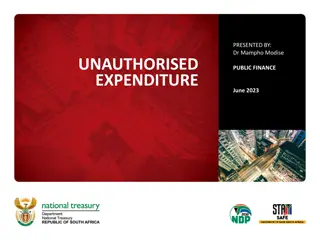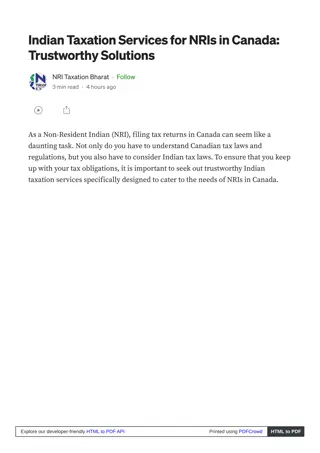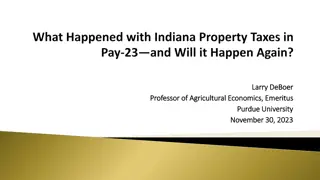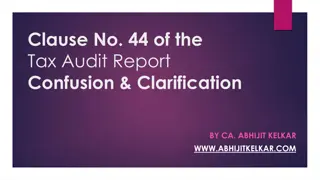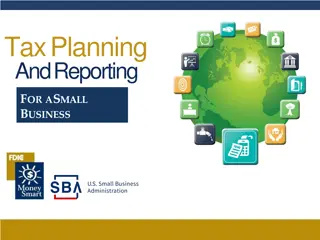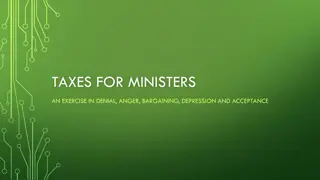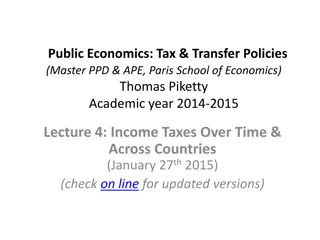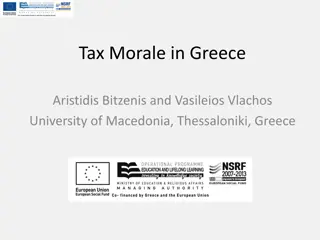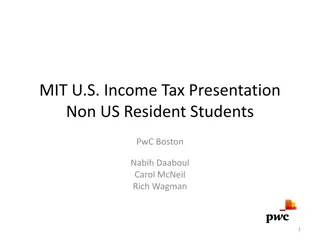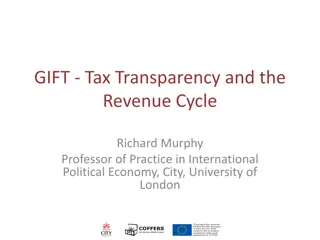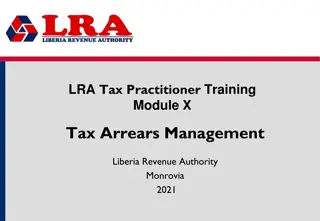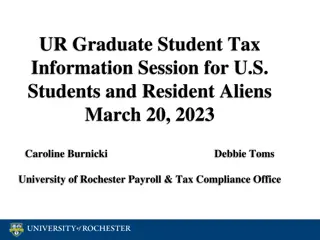Comparative Analysis of Tax Expenditure Reporting Practices
Dive into the nuances of tax expenditure reporting across different countries based on insights shared at the National Tax Association Annual Conference in 2019 by Agustin Redonda and Tom Neubig.
Download Presentation

Please find below an Image/Link to download the presentation.
The content on the website is provided AS IS for your information and personal use only. It may not be sold, licensed, or shared on other websites without obtaining consent from the author.If you encounter any issues during the download, it is possible that the publisher has removed the file from their server.
You are allowed to download the files provided on this website for personal or commercial use, subject to the condition that they are used lawfully. All files are the property of their respective owners.
The content on the website is provided AS IS for your information and personal use only. It may not be sold, licensed, or shared on other websites without obtaining consent from the author.
E N D
Presentation Transcript
Assessing Tax Expenditure Reporting Across Countries Agustin Redonda and Tom Neubig National Tax Association Annual Conference, 2019
Global Tax Expenditure Database Joint initiative of the Council on Economic Policies and the German Development Institute Objective: Assist policymakers and analysts identify best practices, see gaps, find opportunities for incremental improvements in TE reporting around the globe, and trigger additional research in the tax expenditure field Initial development: OECD and G20 countries Extended to African countries Complimentary with IMF and CIAT TE analyses Important foundation for additional TE efforts and analysis
Dimensions of tax expenditure reporting 1. General information (e.g. year of latest report) 2. Legal (e.g. required, integration with budget) 3. Definitional (e.g. benchmark from which compared) 4. Temporal (e.g. frequency, backward/forward estimates) 5. Estimation (e.g. method, identified vs. estimated) 6. Descriptive (e.g. more than just name) 7. Classification (e.g. tax base, type of relief, budget category) 8. Evaluation (e.g. effectiveness, efficiency) 9. Other (e.g. subnational)
Classification of TE reporting in OECD/G20 Group II Basic TE report Group I No TE report China Czech Republic Brazil Indonesia Japan Luxembourg Russia Saudi Arabia Slovenia* Group III Detailed TE report Australia Austria Canada France Germany Italy Argentina Latvia Mexico New Zealand Norway Belgium Chile Denmark Poland Estonia Finland Greece Hungary Iceland India Indonesia United Kingdom Ireland United States Israel Portugal Slovak Republic Netherlands Spain South Africa Switzerland Turkey Korea Sweden *A law has been already passed and Slovenia should be reporting on Tes as from 2020
Tax expenditure reporting in Africa A. Number of Reports per Country B. Number of Reports per Year TE Reporting in Africa: Number of Countries 12 8 7 10 6 6 5 Number of Reports 8 4 Number of Countries 4 11 34 6 3 15 2 17 4 1 0 2 2005 2006 2007 2008 2009 2010 2011 2012 2013 2014 2015 2016 2017 2018 2019 Year Source: GTED 2019 0 Itemized TE Report Only Overall TE Estimates TE Report Not Public 1 to 2 3 to 5 More than 5 Number of Reports TE Report Underway No TE Information Source: GTED 2019
Quality of TE reporting in Africa Country Revenue Foregone Methodology Detailed Description Legal Reference Tax Base Info Incentive Mechanism Budgetary Category Targeted Beneficiaries Number of Beneficiaries Policy Objective Benin (2019) Burkina Faso (2016) Ivory Coast (2017) Gabon (2018) Guinea (2017) Liberia (2016) Madagascar (2015) Mali (2019) Mauritania (2013) Mauritius (2016) Morocco (2019) Rwanda (2018) Senegal (2014) South Africa (2018) Tanzania (2018)
Share of TEs estimated in Africa 600 100% 90% 500 80% 70% # of TE Provisions 400 % of Total Listed 60% 300 50% 40% 200 30% 20% 100 10% 0 0% 0 2 4 6 8 10 12 14 16 Country Source: GTED 2019 Listed Estimated Share of estimated TEs
African TEs by tax type and share of tax/GDP Country Benin Burkina Faso DR Congo Ivory Coast Gabon Guinea Lesotho Liberia Madagascar Mali Mauritania Mauritius Morocco Rwanda Senegal Sierra Leone South Africa South Sudan Tanzania Average Year 2017 2016 2016 2017 2017 2017 2016 2016 2015 2017 2013 2017 2018 2018 2014 2017 2017 2018 2012 % of Tax Collected 18.2% 8.6% 10.2% 9.8% 12.1% 21.7% 17.6% 18.9% 17.0% 17.3% 58.4% 9.2% 13.0% 14.3% 39.6% 8.8% 14.9% % of GDP 2.4% 1.4% 0.7% 1.3% 1.2% 2.6% 4.0% 4.7% 1.8% 2.6% VAT 62.7% 40.7% 66.7% 69.6% 100.0% 40.0% 38.2% PIT 0.1% CIT 1.5% 21.0% Customs 10.3% 26.1% Stamp Duty 25.0% 8.5% Excise 0.1% 0.0% Others 0.3% 3.8% 33.3% 20.5% 0.0% 15.0% 0.0% 0.0% 22.7% 1.1% 9.1% 0.0% 9.5% 11.8% 7.8% 0.0% 0.0% 100.0% 56.0% 15.3% 9.2% 0.7% 34.0% 11.0% 61.8% 100.0% 42.0% 24.2% 27.1% 2.3% 2.7% 27.5% 9.7% 100.0% 23.3% 24.2% 60.3% 49.1% 33.5% 52.9% 60.7% 45.8% 0.5% 2.5% 11.7% 4.4% 46.0% 15.6% 8.0% 2.7% 0.7% 9.6% 8.0% 15.9% 1.8% 2.8% 4.6% 7.8% 1.2% 3.9% 10.2% 0.9% 2.4% 22.5% 11.4% 2.8% 35.4% 36.6% 4.7% 27.0% 18.7% 4.4% 2.9% 44.0% 51.5% 19.4% 12.8% 33.0% 7.0% 4.4%
Latin American tax expenditures by type of tax and percent of GDP Fernando Pela ez Longinotti, Overview of Tax Expenditures in Latin America: main statistics of the CIAT Database, CIAT Working Paper, 2019
Number of developing countries regularly reporting tax expenditures Kassim and Mansour, 2018. IMF blog, 2019.
Takeaways on current TE reporting globally Evaluating government assistance through tax expenditures is important TE reporting is more extensive in developed than developing countries, yet still wide heterogeneity in reporting among OECD/G20 countries A number of developing countries are providing important information to policymakers and citizens with their TE reporting Additional focus and resources are needed for TE reporting as part of the United Nation s Sustainable Development Goals Additional developing country TE reporting assessment by the IMF and CIAT CEP s Global Tax Expenditure Database is designed to assist policymakers and analysts identify best practices, see gaps, find opportunities for incremental improvements in TE reporting, and trigger additional TE research.
References Directorate-General for Economic and Financial Affairs. Tax expenditures in direct taxation in EU Member States. European Commission. 2014 Heady, C. and M. Mansour (2019). Tax Expenditures and Their Use in Fiscal Management: A Guide to Developing Countries , How to Note 19/01, International Monetary Fund (IMF), https://www.imf.org/~/media/Files/Publications/HowToNotes/HTNEA2019002.ashx. IMF (2019b). Tax Expenditure Reporting and Its Use in Fiscal Management. A Guide for Developing Economies How To Notes 19/01. Washington: International Monetary Fund. IMF, OECD, UN and World Bank (2015). Options for Low Income Countries Effective and Efficient Use of Tax Incentives for Investment , A Report to the G-20 Development Working Group, https://www.imf.org/external/np/g20/pdf/101515.pdf. Kassim, L. and M. Mansour (2018). Les Rapports sur les D penses Fiscales des Pays en D veloppement : Une Evaluation. Revue d' conomie du d veloppement 26(2), 113-167 (in French). IMF (2017). Kenya Fiscal Transparency Evaluation , International Monetary Fund, https://www.imf.org/external/pubs/ft/scr/2016/cr16221.pdf Organisation for Economic Co-operation and Development. 2010. Tax Expenditures in OECD Countries. Paris. Pel ez Longinotti, F. (2018). Overview of Tax Expenditures in Latin America: Main Statistics of the CIAT Database. Working Paper, Inter-American Center of Tax Administrations (CIAT). Redonda, A. (2016). Tax Expenditures and Sustainability. An Overview , CEP Discussion Note 16/03, Council on Economic Policies (CEP). Redonda, A. and T. Neubig (2018), Assessing Tax Expenditure Reporting in G20 and OECD Economies, CEP Discussion Note 2018/3, https://www.cepweb.org/assessing-tax-expenditure-reporting-in-g20-and-oecd-economies/. von Haldenwang, C. and S. Laudage (2019). Financing for Development and Domestic Revenue Mobilisation: More International Reforms Are Needed . Bonn: DIE (Briefing Paper 13/2019).
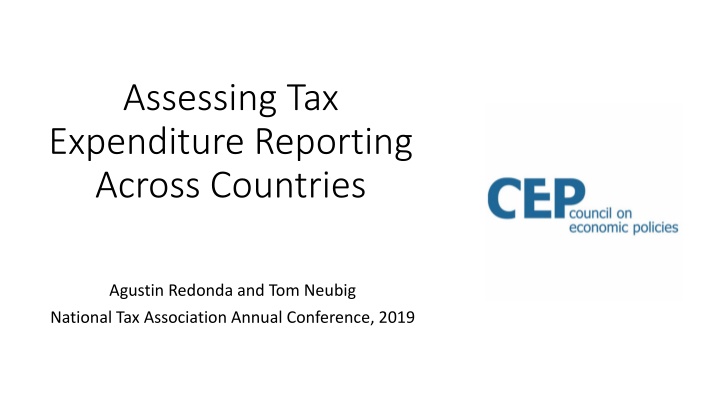

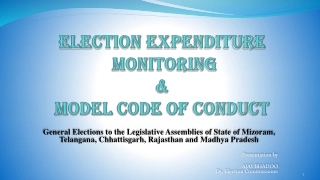
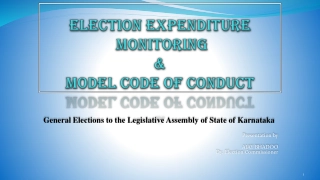

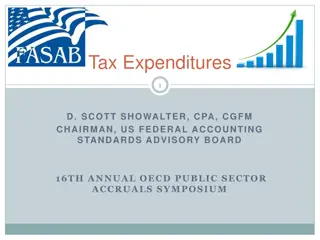

![Town of [Town Name] Real Estate Tax Rates and FY 2024 Budget Summary](/thumb/62211/town-of-town-name-real-estate-tax-rates-and-fy-2024-budget-summary.jpg)

